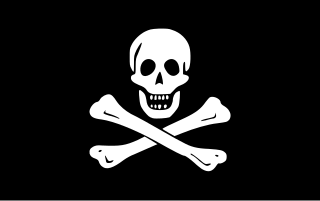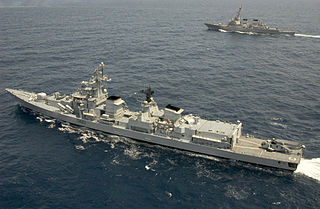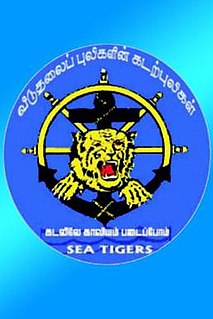
Piracy is an act of robbery or criminal violence by ship or boat-borne attackers upon another ship or a coastal area, typically with the goal of stealing cargo and other valuable goods. Those who conduct acts of piracy are called pirates, while the dedicated ships that pirates use are called pirate ships. The earliest documented instances of piracy were in the 14th century BC, when the Sea Peoples, a group of ocean raiders, attacked the ships of the Aegean and Mediterranean civilizations. Narrow channels which funnel shipping into predictable routes have long created opportunities for piracy, as well as for privateering and commerce raiding. Historic examples include the waters of Gibraltar, the Strait of Malacca, Madagascar, the Gulf of Aden, and the English Channel, whose geographic structures facilitated pirate attacks. A land-based parallel is the ambushing of travelers by bandits and brigands in highways and mountain passes. Privateering uses similar methods to piracy, but the captain acts under orders of the state authorizing the capture of merchant ships belonging to an enemy nation, making it a legitimate form of war-like activity by non-state actors.

The Indian Coast Guard (ICG) is a maritime law enforcement and search and rescue agency of India with jurisdiction over its territorial waters including its contiguous zone and exclusive economic zone. The Indian Coast Guard was formally established on 1 February 1977 by the Coast Guard Act, 1978 of the Parliament of India. It operates under the Ministry of Defence.

INS Mysore is a Delhi-class guided-missile destroyer currently in active service with the Indian Navy.

The Sea Tigers was the naval wing of the Liberation Tigers of Tamil Eelam during the Sri Lankan Civil War. It was founded in 1984. The Sea Tigers had a number of small but effective suicide bomber vessels. During its existence it had gained a reputation as a capable adversary for the Sri Lankan Navy. Over the years the Sea Tigers had sunk at least 29 Sri Lankan small inshore patrol boats and one freighter.

Piracy in the Gulf of Guinea affects a number of countries in West Africa as well as the wider international community. By 2011, it had become an issue of global concern. Pirates in the Gulf of Guinea are often part of heavily armed criminal enterprises, who employ violent methods to steal oil cargo. In 2012, the International Maritime Bureau, Oceans Beyond Piracy and the Maritime Piracy Humanitarian Response Program reported that the number of vessels attacks by West African pirates had reached a world high, with 966 seafarers attacked during the year. According to the Control Risks Group, pirate attacks in the Gulf of Guinea had by mid-November 2013 maintained a steady level of around 100 attempted hijackings in the year, a close second behind Southeast Asia. Piracy in the Gulf of Guinea continues to be a concern to the shipping industry, which is affected significantly. At the same time, governments in the region generally highlight that the fight against piracy requires a broad understanding of maritime security throughout the Gulf of Guinea.
Piracy off the coast of Somalia occurs in the Gulf of Aden, Guardafui Channel and Somali Sea, in Somali territorial waters and other surrounding areas. It was initially a threat to international fishing vessels, expanding to international shipping since the Consolidation of states within Somalia (1998–2006) of the Somali Civil War, around 2000.

The action of 1 April 2010 refers to a pair of naval engagements fought between United States Navy warships, a Sierra Leone merchant ship, and Somali pirate vessels operating off the Seychelles in the Indian Ocean.

Piracy in the 21st century has taken place in a number of waters around the world, including the Gulf of Guinea, Strait of Malacca, Indian Ocean, and Falcon Lake.
The MV Iceberg 1 is a Panama-flagged roll-on/roll-off cargo ship that was hijacked by Somali pirates on March 29, 2010. It was the longest-held hijacked ship until the Puntland Maritime forces released it and 22 crew members on 23 December 2012.

The Battle off Minicoy Island was a single ship action in January 2011 between Indian naval forces and Somali pirates, during Operation Island Watch. Pirates in the former Thai fishing trawler Prantalay 14 resisted and attacked the Indian Navy warship Cankarso and, in a long surface action off Minicoy Island, the Indians sank the hostile ship and rescued twenty captives.

Operation Ocean Shield was NATO's contribution to Operation Enduring Freedom – Horn of Africa (OEF-HOA), an anti-piracy initiative in the Indian Ocean, Guardafui Channel, Gulf of Aden and Arabian Sea. It follows the earlier Operation Allied Protector. Naval operations began on 17 August 2009 after being approved by the North Atlantic Council, the program was terminated on 15 December 2016 by NATO. Operation Ocean Shield focused on protecting the ships of Operation Allied Provider, which transported relief supplies as part of the World Food Programme's mission in the region. The initiative also helped strengthen the navies and coast guards of regional states to assist in countering pirate attacks. Additionally, China and South Korea sent warships to participate in these activities.
The Puntland Maritime Police Force (PMPF) is a security force based in Puntland, an autonomous region in northeastern Somalia. As of March 2012, the PMPF had around 500 personnel. The force is eventually expected to comprise 10,000 personnel.
The Enrica Lexie case is an ongoing international controversy about a shooting off the western coast of India. On 15 February 2012, two Indian fishermen were killed off the coast of Kerala, India, aboard St. Antony. India alleged that the two Italian marines aboard the Italian-flagged commercial oil tanker MB Enrica Lexie killed the fishermen.
AdvanFort is a US private maritime security company founded in 2009 and headquartered in Herndon, Virginia. It focuses on defense and homeland security products, technologies and services. Currently it has more than 100 employees and 200 contractors. In addition to groups of security teams working in several areas of the world and a fleet of operator support vessels in the Indian Ocean, the company has both a mission operations center and a threat analysis center. Until July 2013, it published weekly global piracy threat analysis, available without charge on its website.

Operation Dawn 8: Gulf of Aden was a naval operation carried out by the Royal Malaysian Navy against pirates in the Indian Ocean on 20 January 2011. In response to the hijacking of MV Bunga Laurel, the Malaysian Shipborne Protection Team deployed an attack helicopter and 14 members of the naval counter-terrorism group PASKAL in two rigid-hulled inflatable boats to retake the vessel and rescue the crew. After one night of trailing the tanker, the Malaysian forces successfully retook the ship by force on 20 January 2011, resulting in the wounding of three and the capture of four out of 18 pirates, and all 23 vessel crewmembers rescued.
Piracy has taken place in a maritime area bounded by Suez and the Strait of Hormuz, in the region around the Horn of Africa, and waters surrounding the Arabian Peninsula; in the region of the Indian Ocean from the Red Sea through the Arabian Sea to the Gulf of Oman.
Floating armouries are vessels used to store military grade weapons. Being in possession of military-grade weapons in most jurisdictions is highly controlled. In the early twenty-first century, piracy in international waters became a serious issue for shipping companies. In response, services that supply weapons on the high seas, often referred to as floating armouries, were implemented. These armouries provide transfer services to private maritime security companies (PMSCs); the controlled weapons are available in international waters, but never enter patrolled territorial waters—they are delivered by an armoury to a client's vessel, and returned, in international waters.
MV OS 35 is a bulk carrier registered in Tuvalu, a flag of convenience. The vessel came into news when a piracy attack on her off the coast of Somalia was thwarted jointly by ships of China’s People’s Liberation Army Navy and of the Indian Navy.










